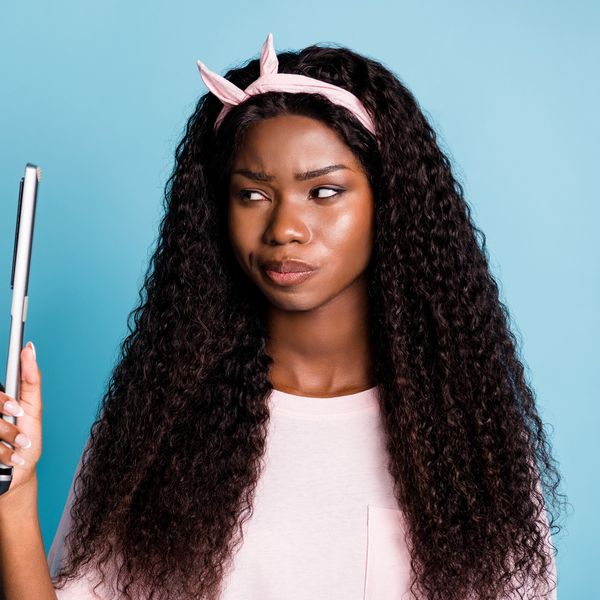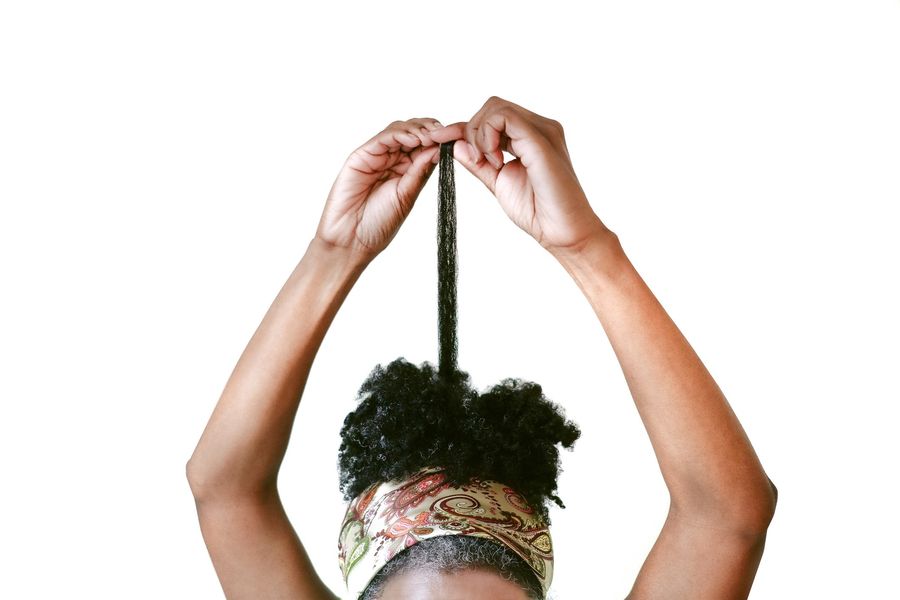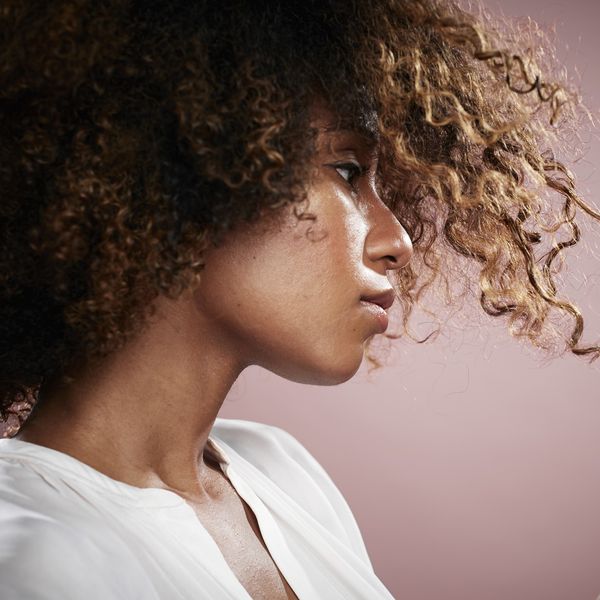
The fear of heat damage has been instilled in me since I went natural six years ago. Since then, I vowed to take my hair health seriously and put that above all else, unfortunately, straightening my hair didn’t seem to align. People will constantly tell me, “Don’t straighten your hair, it’ll mess up your curls.” I heard this so much that it made me nervous every time I had to do it.
However, I would also see other naturals wear their hair straight, only for it to revert right back to its tight curly pattern. It made me curious, and I started to ask different natural hair stylists whether the myth was true. They all responded, “You can, but not too much.”
In case you're like I was and are a little hesitant about applying heat to your hair out of fear of damage, I want to debunk a lot of the hair-straightening myths so you don’t have to be afraid to switch up your style every now and then. Here’s the truth about heat on natural hair and how to prevent damage.
Straightening Your Hair Isn’t Bad
Don’t listen to the naysayers, the only person you should listen to is your stylist. If you’re considering switching up your curly hairstyles for something sleekier, your stylist will guide you and give you tips on the best way to do that.
One of the benefits of natural hair is that it’s typically stronger and has high elasticity to fight breakage and damage. Plus, natural hair is versatile and not confined to just one style or look. In fact, my hairstylist, Aliya Abbey of Mane Mastery, says:
“One myth that I tend to see when it comes to natural hair is we need to stay away from all heat – blow drying and straightening. While some naturals prefer to avoid heat completely, it can actually work against you. Stretching the hair for trims gives more precision and a better look at the overall health of the strands, whereas curls can camouflage split ends and damage.”
There’s No Specific Rule Book
Generally, there are best practices for maintaining healthy hair, but truth be told, it’s not one size fits all. Hair texture, porosity, health, etc., all play a role in what you can do and how to do it. What may work for you may not work for others, and vice versa. Aliya continues, “Some hair strands can withstand more heat than others.”
It’s important to know your hair so you can create a routine and plan that works best for you.

Grace Cary/Getty Images
Moderation and Minimization Are Key
As I mentioned before, too much of anything can be bad for you. When thinking of straightening your hair, protective styles, etc., it’s important to be aware of how often you're manipulating your hair. In general, a lot of naturals can’t keep our hands out of our hair, it kinda comes with the territory.
Implementing a low-manipulation routine can minimize breakage, create stronger hair strands, and promote hair growth. It’s not always what you do but how much you’re doing it. In terms of how often you should straighten your hair, Aliya adds that “straightening more than two times a month could cause weakness in the hair."
Use the Right Tools
I used to think all heat tools were the same. I've always based healthy straightening practices on technique. While that's true, the tools you use are just as important. The cheaper blow dryers and flat irons tend to overheat your hair or not straighten your hair well enough. When it comes to flat irons, it is best to get one where you can control the heat via temperature instead of high and low. This will allow you to see how much heat you're putting on your hair and have control.
On the other hand, if the blow dryer or flat iron isn't of quality, it will require you to pass through your strands more than necessary and possibly burn your hair. "Heat damage is caused by tools that are too hot, tools that are being passed by a section of hair too many times, and/or dehydrated hair. It's important to take note of the type of tools being used and the frequency of straightening. Don't forget to steam and hydrate!"

Willie B. Thomas/Getty Images
Heat Damage Is Preventable
One last fact about straightening natural hair is that heat damage is preventable, not inevitable. There are a few ways to avoid heat damage, one being steam and deep conditioning your hair. Doing this not only makes the strands more hydrated but also stronger.
Secondly, using a heat protectant is important. It creates a barrier between hair and heat exposure to protect your strands.
Lastly, have a professional do it. If you don't know what you're doing, get someone who does. Using the right care and technique can save you and your hair a lot of stress. Seeing a stylist who specializes in natural hair and silk presses can promote strong, healthy hair and avoid heat damage.
Don't be like me and let the unnecessary fear of heat deter you from your versatility. As long as you prioritize your hair health, you'll be okay. I follow the exact same routine with the help of my stylist, and my hair thickness, elasticity, and health have never been compromised.
Let’s make things inbox official! Sign up for the xoNecole newsletter for daily love, wellness, career, and exclusive content delivered straight to your inbox.
Featured image by Deagreez/Getty Images
- Everything You Need To Know About Perfecting An At-Home Blowout ›
- 8 Hair Masks & Deep Conditioners That Revitalize Dry, Damaged Hair ›
- Silk Press Season Is Underway & Here's What You Should Know About It ›
- I Tried Olaplex On My Natural Hair For 30 Days & Here's What Happened ›
- A 4-Step Process That Actually Prevents Heat Damage ›
- 6 Ways To Achieve A Straight Look On Natural Hair Without Heat Damage ›
Freelance writer, content creator, and traveler. She enjoys the beauty of simplicity, a peaceful life, and a big curly fro. Connect with Krissy on social media @iamkrissylewis or check out her blog at www.krissylewis.com.
Eva Marcille On Starring In 'Jason’s Lyric Live' & Being An Audacious Black Woman
Eva Marcille has taken her talents to the stage. The model-turned-actress is starring in her first play, Jason’s Lyric Live alongside Allen Payne, K. Michelle, Treach, and others.
The play, produced by Je’Caryous Johnson, is an adaptation of the film, which starred Allen Payne as Jason and Jada Pinkett Smith as Lyric. Allen reprised his role as Jason for the play and Eva plays Lyric.
While speaking to xoNecole, Eva shares that she’s a lot like the beloved 1994 character in many ways. “Lyric is so me. She's the odd flower. A flower nonetheless, but definitely not a peony,” she tells us.
“She's not the average flower you see presented, and so she reminds me of myself. I'm a sunflower, beautiful, but different. And what I loved about her character then, and even more so now, is that she was very sure of herself.
"Sure of what she wanted in life and okay to sacrifice her moments right now, to get what she knew she deserved later. And that is me. I'm not an instant gratification kind of a person. I am a long game. I'm not a sprinter, I'm a marathon.
America first fell in love with Eva when she graced our screens on cycle 3 of America’s Next Top Model in 2004, which she emerged as the winner. Since then, she's ventured into different avenues, from acting on various TV series like House of Payne to starring on Real Housewives of Atlanta.

Je-Caryous Johnson Entertainment
Eva praises her castmates and the play’s producer, Je’Caryous for her positive experience. “You know what? Je’Caryous fuels my audacity car daily, ‘cause I consider myself an extremely audacious woman, and I believe in what I know, even if no one else knows it, because God gave it to me. So I know what I know. That is who Je’Caryous is.”
But the mom of three isn’t the only one in the family who enjoys acting. Eva reveals her daughter Marley has also caught the acting bug.
“It is the most adorable thing you can ever see. She’s got a part in her school play. She's in her chorus, and she loves it,” she says. “I don't know if she loves it, because it's like, mommy does it, so maybe I should do it, but there is something about her.”
Overall, Eva hopes that her contribution to the role and the play as a whole serves as motivation for others to reach for the stars.
“I want them to walk out with hope. I want them to re-vision their dreams. Whatever they were. Whatever they are. To re-see them and then have that thing inside of them say, ‘You know what? I'm going to do that. Whatever dream you put on the back burner, go pick it up.
"Whatever dream you've accomplished, make a new dream, but continue to reach for the stars. Continue to reach for what is beyond what people say we can do, especially as [a] Black collective but especially as Black women. When it comes to us and who we are and what we accept and what we're worth, it's not about having seen it before. It's about knowing that I deserve it.”
This interview has been edited for length and clarity.
Let’s make things inbox official! Sign up for the xoNecole newsletter for love, wellness, career, and exclusive content delivered straight to your inbox.
Feature image by Leon Bennett/WireImage
We don’t get to choose the order we’re born into, but it’s wild how much it can shape who we become. Though birth order may seem like an inconsequential family fun fact, it can influence how we move, love, lead, and even how we see ourselves. Whether you're the dependable oldest, the often-overlooked middle child, the free-spirited baby in the family, or the only child who grew up as their own best friend, there's a chance a few of your core personality traits are tied to the role you played growing up.
Eldest Daughter Syndrome had its viral moment online last year, and for good reason. The term gave language to the silent pressures so many eldest daughters tend to carry as a result of their birth order. Beyond that very needed conversation, birth order as a whole can offer insight into not only our traits and tendencies, but also how we show up in life, love, and even our work.
Below, we’re breaking down the traits most commonly associated with each birth order. Keep reading to learn what your birth order might say about you.
If you are the oldest...

Let's be real, being the firstborn often comes with a lot of responsibility. And it's usually not by choice. From early on, they’re the ones who set the tone, carry the weight, and take on the title of "the responsible one." Because of that, they often grow into reliable, high-achieving adults. But the pressure of being "the blueprint" and the one to "lead by example" can also be a heavy burden to bear.
Oldest child traits may look like:
- Natural leaders that take charge even when they didn’t mean to (read: she's bossy, but keeping it cute)
- High standards (for yourself and everyone else)
- Motivated, goal-oriented, and always chasing that next accomplishment
- Reliable and conscientious
- Perfectionist tendencies that can lead to burnout
- Struggles with being controlling or micromanaging
- Often cautious, craving stability over spontaneity
- Finds it hard to rest or ask for help
If you are the middle child...
 Season 2 Netflix GIF by Gilmore Girls Giphy
Season 2 Netflix GIF by Gilmore Girls GiphyIn the grand scheme of the birth order lineup, the middle child can be the quiet MVPs. As the child who falls in the order "in-between," they’re used to being the one who keeps the peace while also fighting to stand out. But being the “in-between” can also mean feeling overlooked or forgotten. In some families, especially ones with toxic dynamics, the middle child may even take on the role of the "black sheep," while their siblings are seen as the golden children. Still, despite (or maybe because of) that, middle children tend to thrive socially and can read a room like the back of their hand.
Middle child traits may include:
- Top-tier peacemakers who can smooth over almost any situation
- Adaptable and easygoing (even when they’re lowkey screaming inside)
- Often feel overlooked or like they have to do the most to be seen
- People-pleasers who put everyone else first
- Social butterflies and community-minded, with strong friendships outside the family
- Can be rebellious when they feel boxed in
- Thrive when they’re allowed to define success on their own terms
- The ultimate go-between, translating vibes between generations, personalities, and moods
If you are the youngest...
 Season 1 Ff GIF by FreeformGiphy
Season 1 Ff GIF by FreeformGiphyThe baby of the family walks through life knowing how to charm, persuade, and perform. They often grow up with more freedom and fewer expectations, which fuels their adventurous and carefree side. But that same freedom can sometimes lead to entitlement, or a tendency to seek validation by being the "fun one."
Youngest child traits might include:
- Social butterflies who light up a room and don’t mind the spotlight
- Natural charmers, funny, flirtatious, and usually down for anything
- Can be a little self-centered or attention-seeking (but you still love them for it)
- Tend to keep things uncomplicated… unless they’re not getting their way
- Known to be manipulative when trying to get what they want
- Free-spirited and bold in their choices
- Often underestimated, but capable of big things when they focus
- Thrive in spaces that let them express, explore, and be a little extra
If you are the only child...
 High School Drama GIF by HBO MaxGiphy
High School Drama GIF by HBO MaxGiphyOnly children can be the ultimate "one woman show" as they are often a mix of all the birth orders rolled into one. Without siblings, they learn to entertain themselves, advocate for their needs, and navigate adult conversations early. That independence can make them magnetic, mature, and deeply introspective, but it also comes with a deep craving for validation and control.
Only child traits can include:
- Mature and wise beyond their years, often viewed as old souls
- Conscientious and responsible, usually the go-to person in their circle
- Seek approval and validation more than they let on
- Natural leaders with big ideas and even bigger plans
- Can be sensitive and deeply affected by criticism
- Prefer structure, routines, and control (sometimes to a fault)
- Like things done their way (and don’t love compromising)
- Thrive in solitude but still want to feel seen and celebrated
Let’s make things inbox official! Sign up for the xoNecole newsletter for love, wellness, career, and exclusive content delivered straight to your inbox.
Featured image by KALA STUDIO/Getty Images










